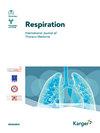Endobronchial Seeding of Tuberculous Granulomas after EBUS-TBNA of Mediastinal Lymph Nodes: Case Report.
IF 3.5
3区 医学
Q2 RESPIRATORY SYSTEM
引用次数: 0
纵隔淋巴结EBUS-TBNA术后结核性肉芽肿的支气管内播种。
一位36岁非吸烟、免疫功能正常的女性患者因咳嗽、体重减轻和全身不适而入院。CT扫描显示左上叶肿瘤伴病理性纵隔淋巴结。对肿瘤及EBUS淋巴结11L、7、4R行支气管镜活检。组织学检查显示肉芽肿性炎症伴坏死和罕见的结核杆菌(图1)。培养呈阴性,但Xpert MTB/RIF检测结核呈阳性,抗生素耐药性呈阴性。患者接受标准的6个月结核病治疗,但6个月后随访CT显示淋巴结及病变本身略有增加,并出现新的支气管内病变,与穿刺部位相对应。在重复支气管镜检查后,在先前用EBUS-TBNA取样的所有三个部位均发现肿瘤样生长,并将其完全切除(图2)。组织学检查显示肉芽肿伴坏死,但没有细菌、真菌或结核杆菌的存在。Xpert MTB/RIF仍然呈轻微阳性(图3)。临床好转的患者没有重新接受治疗,而是进行了一年的仔细观察。在此期间,CT上的变化消退,痰培养仍为阴性。在本病例中,我们描述了在先前的EBUS-TBNA产生的穿刺束部位发生的医源性瘘管,结核通过其扩散到气道管腔。EBUS-TBNA后支气管内播种在文献中可能被低估了(1-2)。类似的瘘管也可能在EUS-B的食道中形成,尽管迄今为止还没有报道。然而,我们认为,在考虑对疑似结核病患者的纵隔淋巴结进行侵入性诊断时,强调并认识到结核病形成瘘管的倾向是很重要的。
本文章由计算机程序翻译,如有差异,请以英文原文为准。
求助全文
约1分钟内获得全文
求助全文
来源期刊

Respiration
医学-呼吸系统
CiteScore
7.30
自引率
5.40%
发文量
82
审稿时长
4-8 weeks
期刊介绍:
''Respiration'' brings together the results of both clinical and experimental investigations on all aspects of the respiratory system in health and disease. Clinical improvements in the diagnosis and treatment of chest and lung diseases are covered, as are the latest findings in physiology, biochemistry, pathology, immunology and pharmacology. The journal includes classic features such as editorials that accompany original articles in clinical and basic science research, reviews and letters to the editor. Further sections are: Technical Notes, The Eye Catcher, What’s Your Diagnosis?, The Opinion Corner, New Drugs in Respiratory Medicine, New Insights from Clinical Practice and Guidelines. ''Respiration'' is the official journal of the Swiss Society for Pneumology (SGP) and also home to the European Association for Bronchology and Interventional Pulmonology (EABIP), which occupies a dedicated section on Interventional Pulmonology in the journal. This modern mix of different features and a stringent peer-review process by a dedicated editorial board make ''Respiration'' a complete guide to progress in thoracic medicine.
 求助内容:
求助内容: 应助结果提醒方式:
应助结果提醒方式:


